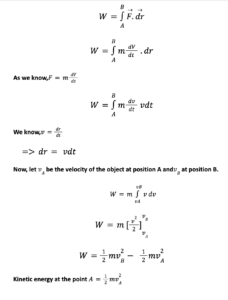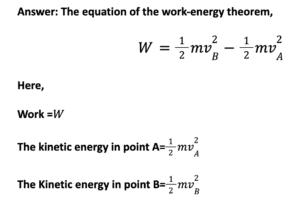
Introduction
The work-energy theorem states that the net work done by the net forces acting on a particle is equal to the change in the kinetic energy of the particle. After the net force is removed the particle’s total energy is changed due to the work that was done. The work-energy theorem is not independent of Newton’s second law. It may be viewed as a scalar form of the Second law and holds in all inertial frames. It can be extended to non-inertial frames provided we include the pseudo force in the calculation of the total force acting on the particle under consideration.
What is the work-energy theorem?
The work-energy theorem states that the amount of net work done by a force on a particle is equal to the change in the kinetic energy of the particle.
Work done = Change in kinetic energy
Description
Before going into the work-energy theorem let us first describe what is work and what is energy.
Work
A force acts upon a body causing a displacement called work. It is simply the product of force and displacement. It has only magnitude and no direction. so, it is a scalar quantity. The unit of measurement is the joule.
Example
Throwing a ball, lifting a heavy thing, pushing a chair or table, riding a horse, etc.
Work in moving a body against gravity depends only on the initial and final positions of the body but not upon the path taken. This shows that gravitational force is a conservative force.
Work can be either positive or negative or zero.
positive work is when force and displacement are in the same direction for an object, then the work done is considered positive.
Example
- Pushing a chair forward. If we push the chair the direction of the force created by us is the same as the chair displacement.
- Kicking a football
- When an object falls under free fall.
Negative work is when force and displacement act in opposite directions for an object, we know it as negative work.
Example
- When an object is thrown upwards gravity does the negative work. Here, the gravitational force is acting downwards but the displacement of the object is upwards.
- We drag someone backward when he tries to move forwards.
- Stopping a moving car by applying brakes.
Zero work is if the direction of the force and displacement are perpendicular to each other, then the network by the force on an object is zero. This is called zero work done through the object.
Example
- Pushing a rock. When we push forcefully against a rock, the force we are exerting on the rock is ineffective since the rock’s displacement is zero.
- A man sitting in a chair.
- Walking while holding an object.
Energy
In physics, energy is the numerical property that is transferred to a body for work done. In one word, the capacity to work is known as energy. Energy can be converted into another form, but not created or destroyed. Energy is the product of power and time. The unit of energy is also joule. There are many types of energy including kinetic energy, potential energy, chemical energy, thermal energy, electrical energy, and nuclear energy.
What is potential energy?
In physics, potential energy is the energy that is stored in an object due to its position. The SI unit of potential energy is the joule. There are various forms of potential energy like electrical potential energy, nuclear potential energy, gravitational potential energy, chemical potential energy, etc. Potential energy cannot be transferred from one object to another.
Example
River water at the top of the waterfall
A box on a table before it falls on the floor.
Potential energy cannot exist for all forces. Potential energy can only exist for conservative forces, whereas kinetic energy is always well existed.
Here, we mainly focus on kinetic energy.
What is kinetic energy?
Kinetic energy is the energy of an object acquired due to its motion. Any object in motion uses kinetic energy.
Example
- A moving car
- Bullet fired from a gun
- Flying an airplane
- A person walking
Some important points
- When the force and displacement are in the same direction, the kinetic energy of an object increases. The increase in kinetic energy is equal to the work done on the object. So, we can write, that if the work done is positive the kinetic energy increases.
- On other hand, when the force and displacement are in opposite directions, the kinetic energy of an object decreases. The decrease in kinetic energy is equal to the work done by the object against the decelerating force. If the work is negative the kinetic energy decreases.
- In deriving the work-energy theorem, it has been assumed that the work done by the force is effective only in changing the kinetic energy of the object. However, the work done on an object may also be stored as the potential energy of the object.
- The concept of potential energy applies to only those forces where the work done against the force gets stored up as energy under the position or configuration of the body. When external constraints are removed, this energy appears as kinetic energy.
What is conservative and non-conservative force?
Conservative force
A force is said to be conservative if the work done on a particle does not depend on the path. For a conservative force, the work done in a closed path is zero. Gravitational forces and spring forces are examples of conservative forces.
Conservative forces depend only on the position of the particle. When a particle moves from one place to another, the force changes the potential energy of the particle by an amount that does not depend on the path.
Non-conservative force
A force is said to be a non-conservative force if the work done on a particle is dependent on its path. The frictional force is an example of a non-conservative force.
Derivation of the work-energy theorem
Let there be a particle of mass ‘m’ displaced from ‘A’ to ‘B’ due to the force ‘F’ acting upon it. Then work done W, by the force on the particle is moving it from position A to position B is given by the following line integral:


We know that a Change in kinetic energy = Kinetic energy at point A – Kinetic energy at point B.
so, Work done = Change in kinetic energy
This is the equation of the work-energy theorem.
Example of the work-energy theorem
- An example of the work-energy theorem is a skydiver’s parachute, when a skier waits at the top of the hill before taking off, they have potential energy. Once the skier takes off down the hill the potential energy is converted into kinetic energy because the skier is now in motion.
- When we raise a dumbbell over our heads, the work done on the dumbbell by us changes its kinetic energy. This is also an example of the work-energy theorem. Here, also we change its potential energy in kinetic energy because it is a change from a state of rest to a state of motion.
Application of Work-Energy theorem
The work-energy theorem helps us to calculate how much work is done by the total force on the body.
The work-energy theorem is very useful in analyzing situations where a rigid body should move under several forces. A rigid body only has kinetic energy. The work done by any force acting on a rigid body is equal to the changes in its kinetic energy. It is the base of the Work-Energy equation for rigid bodies.
Q&A
1. What is the Work-energy theorem?
Answer: The work-energy theorem states that the net work done by the net forces acting on a body is equal to the change in kinetic energy of the particle. The work-energy theorem helps us to calculate how much work is done by the total force on the body.
2. When to use the work-energy theorem?
Answer: The work-energy theorem only applies to the network. It is not valid for the work done by a single force.
3. Which equation expresses the work-kinetic energy theorem?

Written By: Sumita Banerjee
